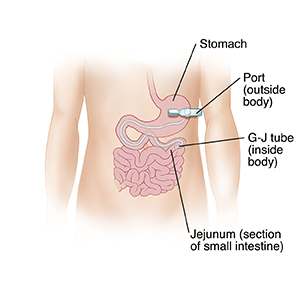Your Gastro-Jejunum (G-J) Tube
You are going home with a gastro-jejunum tube (G-J tube) in place. The G-J tube is put through the abdominal wall into your stomach. It extends into the jejunum, a part of the small intestine.
The G-J tube sends liquid food directly to your stomach or small intestine. You have been given this tube specifically to get liquid food into your small intestine. The G-J tube gives you the nutrition you need.

What to know
There are many types of G-J tubes, syringes, and feeding pumps. Some syringes and tubes are twist on, and others have plug-in tips. Follow your healthcare provider's specific directions for the type of supplies you have. Your tube and supplies may look or work differently from what are described and shown here. Follow the directions from your healthcare provider or home health nurse.
Ask for phone numbers to call if you need help. Also make sure you have the phone number for your medical supply company. You’ll need to order more supplies in the future. Write all these phone numbers below.
Healthcare provider’s phone number:
Home health nurse’s phone number:
Medical supply company’s phone number:
Feeding with a G-J tube
You’ll need to feed yourself through the tube. Your healthcare provider or home health nurse will show you how to do it. You will also learn how to vent air when needed and how to check the balloon if your tube uses a balloon anchor system. If you need more help, talk with your healthcare provider or home health nurse.
You have 2 ports at the end of your tube. One is the gastric port (G-port) that goes directly to your stomach. The other one is the jejunal port (J-port). Make sure you know which one is the J-port. Only use the J-port for liquid food. You may also put liquid medicine in it, if needed. But never put crushed medicine into the J-port.
Ask your healthcare provider if taking medicine by mouth with a sip of water is preferred. If you are not able to take medicine by mouth for any reason, you can put crushed medicine through the G-port using the correct method.
Types of feeding
There are 3 types of feeding with a G-J tube. You may have one or a combination of these. They are:
-
Continuous feeding. This type of feeding is recommended when feeding into the J-port. Liquid food is dripped slowly through the tube for part or all of a day. Continuous feeding is only done using a pump. The amount of food to be given and the time frame are often set on the pump for you. Don't change pump settings unless you’re told to do so.
-
Bolus feeding. This is a meal-sized amount of liquid food given through the tube several times a day. Bolus feeding is given using a syringe or a pump. Bolus feeding is done into the stomach (G-port) but not into the jejunum (J-port). Your healthcare provider or home health nurse will tell you how much liquid food to use for each feeding. You’ll also be told how often to feed yourself.
-
Gravity feeding. A set amount of formula is placed in a feeding bag. It's allowed to flow slowly through the tube for at least 30 minutes per feeding.
Flushing the G-J tube
Your healthcare team will show you how to flush the tube. Make sure you flush the tube regularly as directed to keep it from being clogged. Also make sure you know what not to put in the tube, such as whole pills. If you need help, talk with your healthcare provider or home health nurse.
When to call your healthcare provider
Call your healthcare provider right away if any of the following occur:
-
You have trouble breathing
-
The tube feels loose or comes out
-
The opening where the tube enters the skin becomes larger
-
Red, rough tissue forms around the tube site
-
The tube becomes clogged or blocked and you can't clear it
-
The skin around the tube site has redness, swelling, leaking fluid, or sores
-
You see blood around the tube, in your stool, or in the stomach contents
-
You cough, choke, or vomit while feeding
-
Your belly looks bloated or feels hard when gently pressed
-
You have diarrhea or constipation
-
You have a fever of 100.4°F (38°C) or higher, or as directed by the healthcare provider